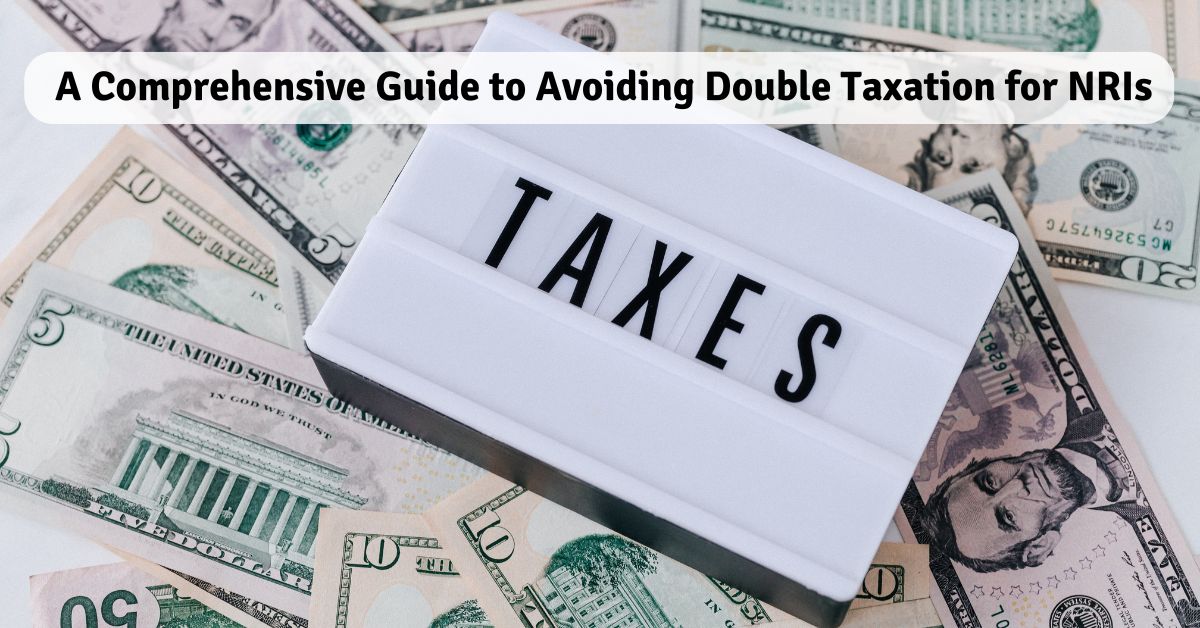A Comprehensive Guide to Avoiding Double Taxation for NRIs
This comprehensive guide explains how NRIs (Non-Resident Indians) can use the Unilateral method and the Bilateral Method supported by Double Taxation Avoidance Agreements (DTAA) to save money and avoid double taxation on their income.
Double taxation, the burden of paying taxes on the same income in two countries, can be a daunting challenge for Non-Resident Indians (NRIs). Fortunately, various mechanisms exist to provide relief and ensure you’re not taxed unfairly. Sections 90 and 91 of the Income Tax Act 1961 relieve taxpayers from paying double Tax. Section 90 applies to cases where India has a bilateral agreement with another nation. In contrast, Section 91 covers cases where India has no bilateral agreement. In both cases, India provides relief to taxpayers.
Relief Methods for NRIs:
There are two main ways NRIs can claim double taxation relief:
(a) Unilateral Method: This method is based on domestic tax legislation in India. It provides relief even without a Double Taxation Avoidance Agreement (DTAA) between India and the source country of your income. To qualify, you need to be a resident of India during the year when the income is earned, the income should be taxable in the foreign country, and you must fulfil tax obligations on the foreign income in that country.
- Benefit: Unilateral relief allows you to deduct a portion of the foreign Tax paid from your Indian tax liability, reducing your overall tax burden.
- Let us understand this with an example –
- Let’s consider Yash, a resident Indian working as a consultant in Canada. He earns a yearly income of CAD 100,000. Canada taxes his income at a rate of 25%. Since he’s a resident Indian, his worldwide income, including the Canadian consulting income, would be taxable in India. Unilateral relief could be a relevant strategy to avoid double taxation on his Canadian income.
- Foreign Tax Paid: Canada taxes Yash’s income: CAD 100,000 * 25% tax rate = CAD 25,000 Tax paid.
- Indian Tax Liability (Without relief): Suppose the Indian tax rate for Yash’s income is 30%. Without unilateral relief, Yash would owe CAD 100,000 * 30% tax rate = CAD 30,000 (converted to rupees) in Indian taxes. This is on top of the CAD 25,000 he already paid in Canada.
- Unilateral Relief Benefit: Unilateral relief allows Yash to deduct a portion of the Canadian Tax paid from his Indian tax bill. He can deduct the lower tax amount between India and Canada. In this case, the Canadian Tax (CAD 25,000) is lower than the Indian Tax (₹30,000 CAD equivalent).
- Tax Reduction: Yash can deduct CAD 25,000 from his Indian tax liability. This reduces his Indian tax burden to ₹30,000 CAD equivalent – CAD 25,000 = ₹5,000 CAD equivalent (approximately).
- To avail benefits from a unilateral agreement, an individual must provide the following documents promptly to the relevant authority:
- A copy of the passport
- A copy of the visa
- A copy of the PAN card
- A copy of the tax residence certificate (TRC)
- A copy of the contract or appointment letter
- A certificate from the employer stating the salary and other details
- A declaration form
(b) Bilateral Method: This method utilizes Double Taxation Avoidance Agreements (DTAAs) signed between India and other countries. A Double Taxation Avoidance Agreement (DTAA) is a deal between two or more countries to help taxpayers avoid paying taxes twice on the same money they earn. These agreements kick in when someone lives in one country but earns cash in another. They can cover all types of income or only certain ones, like money from shipping, inheritance, or air transport. The goal of a DTAA is to make a country seem like an excellent place to invest by either not taxing income earned in another country for residents or taxing it at a lower rate. For example, if you go to work in another country for a while and get paid there, you might have to pay taxes in both countries on that money. The individual can claim relief when filing a tax return for that financial year, provided an applicable DTAA.
These agreements provide relief through two primary methods: exemption and tax credit.
- Benefits: Depending on the specific DTAA, you might be eligible for:
- Lower tax rates on specific types of income earned abroad, such as interest on bank deposits or dividends from foreign companies.
- Complete exemption from taxes on specific income categories in one country.
- Tax credit for foreign taxes paid, minimizing or eliminating the withholding tax burden on foreign income.
- India has signed a Double Taxation Avoidance Agreement (DTAA) with more than 80 countries, including Australia, Canada, the United Arab Emirates, Germany, Mauritius, Singapore, the United Kingdom, and the United States of America.
- Documents needed to claim benefits under DTAA:
- A copy of the passport
- A copy of the visa
- A copy of the PAN card
- A copy of the tax residence certificate (TRC)
- A copy of the contract or appointment letter
- A certificate from the employer stating the salary and other details
- A declaration form
- Claiming Benefits: To claim these benefits, NRIs typically need to submit documents like Form 10F and a Tax Residency Certificate (TRC) issued by the foreign country’s tax authorities.
- Let us understand this with an example – Imagine Yash, an NRI living in the US, earns interest income from investments in India.
- The exemption method offers a clear-cut solution to avoid double taxation altogether. If India and the USA have a DTAA that utilizes the exemption method, India, as the source of the revenue, has the right to tax Yash’s interest earnings. The USA, being Yash’s country of residence, exempts this income from taxation because India has already claimed its tax share. In simpler terms, the exemption method eliminates taxation in one country’s income. This method is commonly applied to income streams like dividends, interest, and royalties.
- In the tax credit method, India, as the source country, still taxes Yash’s interest income at a specific rate. When Yash files his US tax return, he declares the income earned in India. The USA allows Yash to claim a tax credit for the taxes he already paid in India. This essentially reduces his US tax liability by the amount he paid in Indian taxes. The tax credit method ensures Yash isn’t taxed twice on the same income. The US tax authorities provide a credit for the taxes he has already paid to India, reducing his overall tax burden. However, it’s important to remember that the credit amount typically has a cap, usually limited to the amount of Tax paid in the source country.
Tax Residency Certificate:
- To get a Tax Residency Certificate (TRC), complete Form 10FA (Application for Certificate of Residence for an agreement under section 90 of the Income Tax Act, 1961) and submit it to the income tax authorities. After they review your application and process it successfully, they will issue the certificate in Form 10FB.
- The TRC shall contain the following information:
- Name of the taxpayer
- Taxpayer’s identification number
- Country of tax residence
- Period for which the certificate is issued
- Address of the taxpayer
- Description of the nature of income
- Amount of income
You May Like to Read: Are DTAA Benefits Applicable to Mutual Funds for NRIs?
Understanding DTAA Benefits:
- Reduced Tax Rates: You might be eligible for lower tax rates on specific income types earned abroad, depending on the DTAA provisions with your resident country.
- Tax Exemptions: Certain income categories, like pension income, might be entirely exempt from taxation in one country under the DTAA.
- Reduced Withholding Tax: When receiving income from abroad, the source country might withhold some taxes. A DTAA can help minimize or eliminate this withholding tax burden.
Taxes covered under DTAA Benefits:
- The following types of taxes are covered under DTAA:
- Capital gains tax
- Income tax
- Wealth tax
- Gift tax
- Estate tax
Understanding your tax liability is crucial for NRIs. The specific method of double tax avoidance applicable to NRIs depends on the DTAA between India and the country of residence. Consulting an advisor familiar with NRI taxation is highly recommended for personalized guidance on maximizing tax benefits and navigating the intricacies of DTAAs.
We would like to hear more about your experience with double taxation. Reach out to us at office@primewealth.co.in





